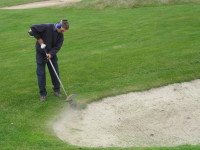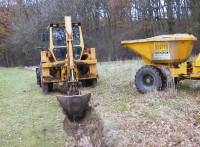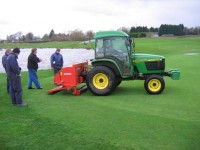February 2010 Golf Diary
 Overview
Overview
Apart from February 2009 and the snow cover which lasted at least a week, the last decade has shown Februaries to be an indication of global warming. Temperatures have been well above the long term average of 3° Celsius whereas rainfall has tended to be slightly lower. Only in 2001 and 2007 were heavy rainfalls recorded as a national average.
Therefore, predicting what may or may not happen in future is anyone's guess. The first signs of growth, more so in the south of England are possible and light levels are slowly on the increase as daylight extends to nearly 11 hours by the end of the month.
Courses can often take on a 'bleached' appearance following many days of sub zero temperatures and cold winds. This is often typical for this time of year when the turf has used up much of its energy reserves. At this time of year the message is 'tread warily or lightly' and avoid causing undue mechanical damage to the turf wherever possible.
Greens
Plant growth will enter February in a dormant state and likely to remain that way for much of the month. However, and in recent years, there have been sufficient milder days for slight signs of growth as day time temperatures rise. In these circumstances, and after probable leaching of nutrients in previous months, a light 'turf tonic' can do wonders for surface condition and presentation.
This involves applying a small amount of Nitrogen, Potassium and Iron, possibly mixed with amendments such as seaweed and humic acids. This should be more of a 'trickle' feed to meet the plant's requirements, since a number of colder days and overnight frosts will inevitably continue for several weeks to come. With February generally being a drier month, there should be several opportunities to aerify the greens at varying depth and to give the surfaces a very light dusting of sand dressing.
The risk of Fusarium disease should be reduced bu,t if mild and wet conditions prevail, then be prepared to act accordingly as listed in previous articles. Mowing should continue as per January, ie cut and roll at 5mm or higher to clean and smooth the surface as opposed to removing grass. Should problem areas arise due to poor draining hollows, surface algae, black layer and so on, look at methods to alleviate these conditions.
Most are likely to relate to surface drainage problems, therefore checking the drains and then ensuring that water reaches the drains are the key requirements. Intensified aerification of such areas, followed by the addition of sand and an amendment such as Axis, will help to dry the surface and allow greater air space within the root-zone.
The objectives are simple, namely to maintain firm, dry and free draining surfaces with good levels of light and air movement. In other words, get the basics right and use modern equipment and availability of new products to assist in producing good turf quality.
Tees
If tees are being rested then fine, little needs to be done other than a trim and tidy and refilling washed out divot holes. Tees that are in use or possibly sand based tees that show a loss of vigour and colour through leaching of nutrients can be lightly fertilised, supplying mainly N & K but only if temperatures are around 6° Celsius.
The aim is to provide firm, dry and level surfaces with sufficient cover of a tight knit grass sward. When conditions are favourable, windows of opportunity should be taken to achieve this objective. Aeration and possible sanding may be required along with any additional worm control. Avoid cutting too low at this time of year since it will only add to the risk of moss invasion.
February is usually the last month to tackle any last minute re-levelling requirements so ensure that any such work is completed by the end of the month, to avoid turf from shrinking and drying out while irrigation systems remain shut down for the winter. This is also the last month to remove markers and signage for cleaning and repainting.
Surrounds
With virtually no growth and zero recovery from any resultant wear, it is essential that the emphasis remains on traffic control measures, sand dressing and possibly some aerification work if ground conditions are favourable. A second application of Carbendazim for worm control may be necessary but this is likely to have been applied earlier. Apart from any last minute turf repairs or drainage work, this should be a quiet month for this part of the course unless there are particular problems to overcome.
Fairways
February is often a key month for deep tine aeration if ground conditions are favourable. As stated in the previous month, operating a deep tiner with varying degrees of 'heave' will prove beneficial for removing surface water and to maximise air movement through the soil. If slitting is the desired option then be aware of cold drying winds opening the surface, particularly on exposed courses on the east side of the UK.
As with surrounds, this is really the last month for any late winter turf repairs or small drainage projects, if the turf is to 'settle-in' prior to the start of the season. By this time of year, any problem areas will have been identified, therefore work should be based on priorities, taking into consideration available funding and resources. Mowing should still continue but only to clean and 'mark' the fairways for presentation. See last month's comment on a winter 'green-up' turf tonic.

Any renovation or drainage work to bunkers should be nearing completion by the end of the month, especially if turfing of banks are involved. Apart from any major work, February is a good month to start work on trimming, edging, cleaning and sanding of bunkers in readiness for the new season. This gives new or additional sand time to 'bed-in', thus avoiding typical member complaints of fluffy lies or balls plugged on the face.
After 'Green Speed', bunkers are the largest issue for member dissatisfaction, therefore planned maintenance work in this area is essential and it is work that needs to be completed to a satisfactory standard. With a high level of importance being attached to bunker playability and presentation, this aspect needs to be part of a club's overall policy and any work should form part of a rolling plan of improvements that is fully documented.
Other
Lakes/Ponds/Ditches: More a continuation of that commented on before, and the need to keep ditches clear from debris and overhanging branches to ensure good water flow. Some may need to be trimmed with a mechanical digger bucket every few years and this work is ideally suited for this time of year as long as ground conditions are suitable.

Paths: February is probably the last month of just topping up pot-holes, edging and scraping of surfaces as part of an on-going winter maintenance plan. Next month, and when courses generally become drier, is the time when re-surfacing work comes more to the fore as the risk of wash-outs and heavy rain become less. Traffic control measures should continue where it is necessary to divert traffic away from main or wet lying areas. These alternative routes are good practice during winter whereby they help to protect the main play areas during the 'off-season'.
Trees: Largely as before, with February being the last winter month to complete such work. See previous diary.
Renovation Projects: With February usually being a drier month, there is often an opportunity to 'catch-up' with unfinished projects and for these to be nearing completion by the end of the month. Early morning frosts are ideal for moving bulk materials, whereas the afternoons can prove more favourable for turfing work. Tees, bunkers, ditch work and 'localised' drainage work are the most common small projects on golf courses, largely to address current issues. Once again, it is important to record and then communicate such work to the club via newsletters, reports & so on, in order to keep golfers up to date with what is happening on their course. Before, during and after photographs is good PR work.
Watchlist:
Disease: Pressure from disease risk is likely to be low to moderate at this time of year, but much will depend on the prevailing weather conditions. Low nutrient content in the soil will be fairly common to many courses after the leaching of plant nutrients therefore turf vigour will be low. This in turn can lead to Fusarium, but generally unlikely. Following prolonged snow cover, snow mold could be a problem but again this is rather unlikely and difficult to predict. Last month's article covered this aspect in more detail.
Pests: Only earthworms are likely to be a nuisance to some areas of the course during February, therefore control from Carbendazim will be required. Since this is more than likely to be a second application at this late stage of the season it should only be applied if really necessary, since the likely impending drier conditions will favour a decline in worm casting.
 Turf Disorders: Apart from previous comments regarding algae and black layer, moss could well be troublesome in many areas. With low levels of light and plant nutrients, the grass loses its competitive edge against moss, perhaps more so on sand based root-zones. It is too early in the season to be aggressive against moss, therefore better to aerify, feed lightly and apply a little Sulphate of Iron to discourage its spread and encourage grass growth. Best to avoid over-feeding since, once temperatures and day light are on the rise, the pendulum swings in favour of grass growth. It is again another example of getting the basics right in the first place.
Turf Disorders: Apart from previous comments regarding algae and black layer, moss could well be troublesome in many areas. With low levels of light and plant nutrients, the grass loses its competitive edge against moss, perhaps more so on sand based root-zones. It is too early in the season to be aggressive against moss, therefore better to aerify, feed lightly and apply a little Sulphate of Iron to discourage its spread and encourage grass growth. Best to avoid over-feeding since, once temperatures and day light are on the rise, the pendulum swings in favour of grass growth. It is again another example of getting the basics right in the first place.
Equipment:
See previous article regarding cleaning and maintenance of equipment. Suffice to say that all major overhauls, servicing and sharpening of equipment should be nearing completion and all such work recorded in a system of service records and wipe board information.
Compound:
If not already started, then this should be the ideal time to operate the 'new broom' strategy with the aim of starting afresh. This means a thorough clean-up and re-organisation of all internal and external areas of buildings and compound. Staff room, toilet and wash areas will probably require a deep clean then a re-paint during days when the weather is less ideal for external work. This work can be completed quickly and once again gives a sense of pride and achievement of a job well done.

February is also an ideal time to catch-up with training staff on some items of equipment and work projects and to bring these records of achievement up to date in the training manual or log book. Another essential requirement is to complete staff appraisals. This is an ideal opportunity to let them know how they are performing and what direction and help each employee needs in order to develop their own careers.
This is a two-way process whereby each staff member expresses his comments and desires on what is important form their well being and personal development. It is also worth remembering that labour costs amount to around 2/3rds of a typical maintenance budget, therefore spending time in this area is sound management.
Laurence Pithie MG
Turf Master One Ltd
www.turfmasterone.co.uk
